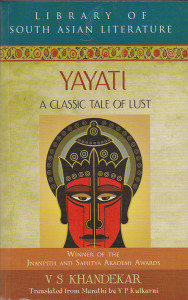Yayati: A Classic Tale of Lust by V.S. Khandekar interprets the mythological tale of Yayati, Devayani, Sharmistha, and Kacha, in an interesting manner, told from the points of view of Yayati, Devayani, and Sharmistha.
The story of Yayati presented in Mahabharatha and puranas, is popular for two themes. 1) A father asking his son to transfer youth to him, to avoid his curse of old age. 2) Indulgence in pleasures that keeps one away from the spiritual path…rather, how indulgence in pleasures is mistaken for happiness.
Sahitya Academy award winner V.S.Khandekar, weaves a meaningful tale through the voices of the key characters as he explores the purpose behind ones’ lives. Especially through characters of Devayani and Yayati, he brings forth the ‘ego’ play in various dimensions and how base emotions can create havoc in internal and external being of the key characters. While all that is bad is portrayed through the two characters Yayati and Devayani, he uses Kacha and Puru for presenting the good or rather the ideal state of human being. Sharmistha and Yati are the two in-between characters who eventually go all the way in the end.
The book is full of interesting observations and quotes on the moral dilemmas of human beings. How many pleasures and how much of them…and how long? Is happiness all about youth? Is youth overrated? Is youth so sought after, as it precedes old age and death? If death is staring at all of our faces and if our present is all we have, should we squander it away without enjoying it? Or should we let it go, to reflect on the bigger meaning of life? Can one enjoy and still be pure? These questions are answered without any judgment through the eyes of the characters. For instance, Yayati ponders on controlling his desire through grihastha ashram (life of a householder), while wondering at the equanimity of Kacha, ascetic. In contrast, Kacha, the ascetic, makes worldly choices for the greater good of the community. This narrative in itself can be considered as a masterstroke. We readers are allowed to make up our mind based on what is presented, thus making an interesting read.
In one of the versions of Yayati story, it is said that he lived a life of 1000 years of pleasure after exchanging his cursed old age with his son Puru and only then he realizes the folly of it to give back his youth. However, in this book, it is compressed to a few minutes but the author uses it to present a great transformation in the key characters. This is nothing short of a coup de grace and uplifts the author’s purpose.
Overall, a great book not just to sample a unique story from Hindu mythology but also open the windows of inquiry into the meaning of life…or to plain simply wonder about the differences between pleasures and happiness. Is a pleasure nothing but a manifestation of ego, while happiness is the dissolution of it? Pleasures are transient but happiness is ongoing? May these questions linger around long after you put down this book.
Tailpiece:
-
The character of Mandar is a very interesting one (dealt briefly) and it has a resemblance to the controversial sex gurus.
-
The plot points so to speak, that cause a change in the character arcs, happen because of Devayani’s action. While Kacha cursed by Devayani, continues to go higher on his ascetic path, Yayati on the other hand when spurned by Devayani, slides down into the abyss of indulgences. The course which one embraces at life’s cross roads, is purely a individual choice, and this is beautifully portrayed in the book. Life is not all fate, perhaps.

